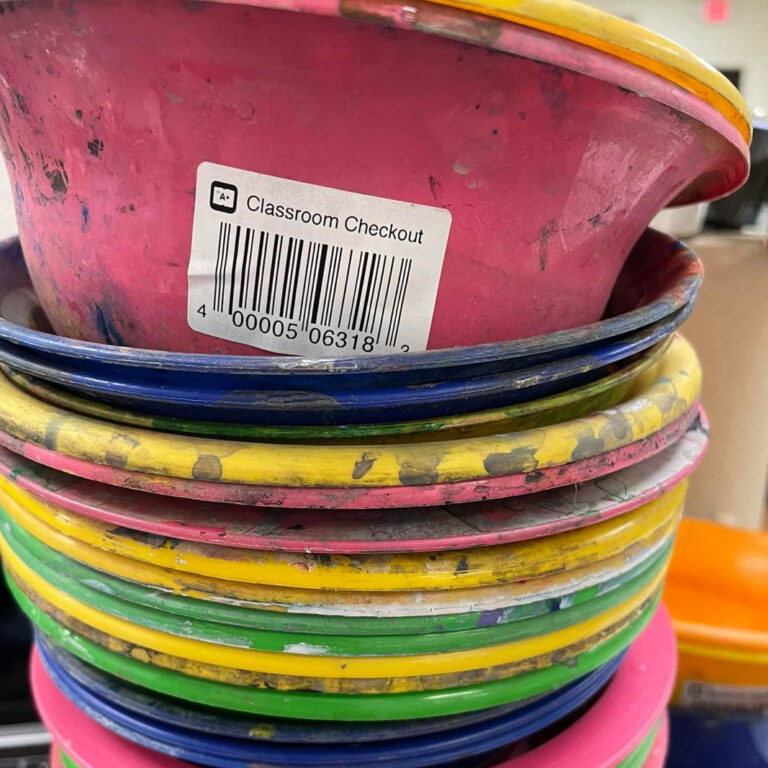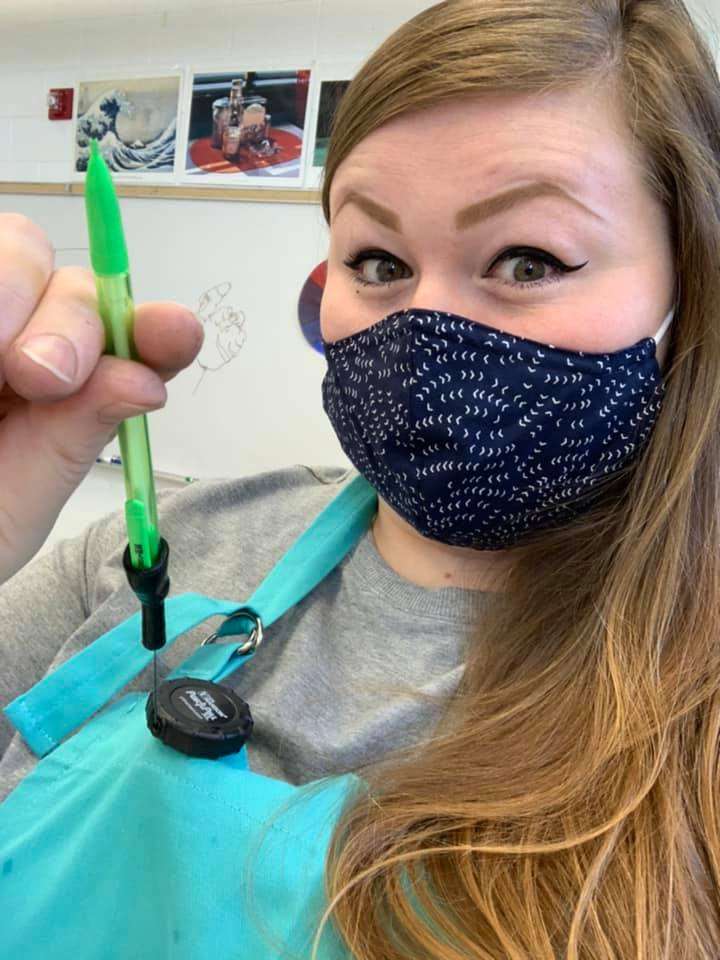When I was in my first years of teaching my now husband and I had an occasion to visit Ikea. In the store was a desk with golf pencils and paper so customers could take notes of product items they wanted to buy. All I could see was FREE pencils. I shamelessly filled up my pockets. My husband-to-be cocked his eyebrow and said, “Does Ikea know they are making a generous donation to your classroom?” I am sure I ignored him or suggested he fill up his own pockets. He also reminded me of another pencil story. At some point in time, I acquired some pencils branded with his high-tech company’s name. They were amazing pencils and my students became enamored with them. Well, my husband was taking a business trip to his company’s headquarters and he asked if I wanted anything from his travels and I asked for more of those pencils. Well, he came home with the company pencils with a price tag on the bundle. I chastised him for buying them, which goes against the rules of being a thrifty art teacher. I just figured he could go into some storeroom and shove a bunch in his pocket, not spend actual money. This logic was all too puzzling for someone who works for a company that provides everything an employee needs.
Pencils are fundamental to teaching art. If you are not in education or maybe you are just embarking on becoming an art teacher, it may come as a surprise to you that students don’t come to class prepared. The struggle over pencils is real and you will need to make some choices about loaning pencils. Now before we dive in I want to share with you this great video that delves into the history of the pencil. If you embark on any pencil projects, you might find this video a great resource to share with your students.
Now, let us get back to the problem at hand: Do you provide a pencil to students and enable their lack of responsibility and preparedness or deny them a pencil making it easy for the student to not participate in class? Here are the strategies that teachers facing this very quandary have developed:
- Take one from me and supply your classroom with golf pencils. It’s an inexpensive and practical solution. Kids don’t love them but it solves the problem and incentives the student to do better in being better prepared for class.
- The agony of providing a new beautiful pencil to a student is incredibly frustrating as it will be long gone before it dies a natural death as a stubby little instrument. Did you know they sell half pencils and golf pencils with erasers? I didn’t! The beauty of this is they won’t ask you for an eraser too, which also goes missing in action all too often. Some teachers will simply cut the full-size pencils.
- Ask for donations at the beginning of the school year when pencils are on sale for the back-to-school season. Ask on your supply list, put it on your Amazon wish list, and mention it at your parent’s night. Nothing ventured, nothing gained. Some art teachers have different grades/classes and bring various basic supplies such as pencils and erasers.
- Recycle! You would not believe how many pens and pencils the custodians sweep up at day’s end. If you are an art teacher, you already know how valuable your relationship with the maintenance staff is. Ask them to save those pencils and you will have more than you can imagine.
- Ask for collateral. Trade a pencil for a shoe, phone, earbuds, etc. It has to be something that they don’t want to leave class without! They get their item back when they hand in the pencil.
- Use humor. I have come across in a few places (so who knows who started this trend) where a teacher had “I love Justin Beiber” printed on their pencils. Students returned them because no one wanted to be caught with such an embarrassing pencil.
- Along a similar vein, tape something to the pencil that makes it over the top obvious that it’s yours and to be returned. Some ideas include taping a feather or plastic spoon, or a tape “flag” to the end of the pencil.
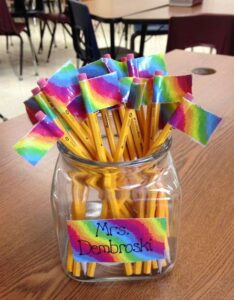
- Cherilyn Donaghey shared her system. “I’ve never been the person that is good with routine, but I’ve gotten fed up with the supplies disappearing and followed in the footsteps of some very organized teachers that have posted! So a couple of weeks ago I set up these buckets. In each bucket are 4 pencils, 1 manual sharpener, and 1 large eraser. And I still have almost every single item! At the end of class, I check each bucket and collect them- and if they have all supplies they earn 5 merits each (we do PBIS) and the kids get another 5 for completing their work and behaving- this is way more than the usual hand out and they have all worked pretty hard to keep their supplies! Even some of the kids that misbehave want to pass the supplies in because it may be the most merits they get for the day!”
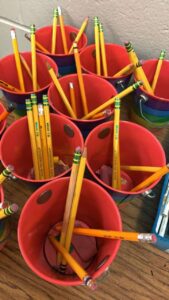
- Some teachers provide a quality pencil to every student at the start of the year. One teacher shares, “I am very clear that this is the only pencil I will give them, and if they come to class without the necessary materials, they will losing weekly participation points. I know this can sound harsh, but I have rarely had an issue with students not having a pencil. They usually borrow one from a friend without making a big deal about it. I also leave a pile of forgotten pencils by my sharpeners.”
- Similarly, Sheryl Smith shared her supply kit, carried over from Covid days. She wrote, “The very best thing I ever did was to create a supply kit for each student. They each had their own materials and had to take care of them. Damage and loss were almost non-existent. When we checked in supplies at the end of the semester, I only had to replace a couple of pencils, sharpies, and rulers. They knew they had to care for those materials as they had to use them for the entire semester. I wish I would have done this years ago!
- The sign-out strategy. These photos are from Pinterest and show some systems where students can sign out a pencil for the period.
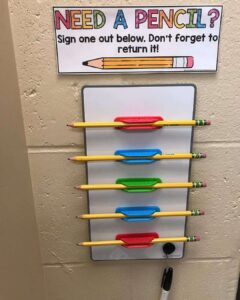
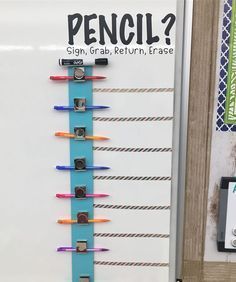 .
. 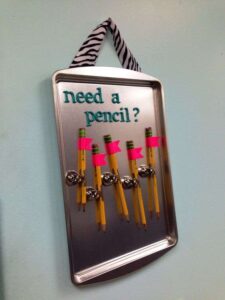

- Buy or create a block pencil holder or hanging pencil holder. You can see quickly at the end of class if all pencils have been returned. It’s also advantageous to make the pencils easily identifiable, such as a unique color, tagged with patterned wasabi tape, etc.

 .
. 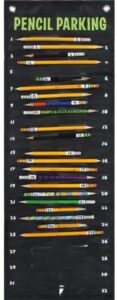
- In my house, we have an expression, “If it’s free it’s for me.” So, here are some places to look for free pencils. Look out for back-to-school promos. Check big stores like Staples or Walmart for freebies. June to August is usually when back-to-school promotions begin, so keep an eye out in the ads for free or very inexpensive pencils. Try making requests directly from manufacturers like Ticonderoga, Faber-Castell, General Pencil Company, General Pencil Company, ForestChoice, Staedtler, and Rotring. Colleges, nonprofits, politicians, etc. are other places to ask for pencil donations. Always mention you are a teacher! Request pencils on Freecycle and other free groups.
- Check out organizations like Kids In Need Foundation, Adopt A Classroom, Donors Choose, and Kids in Need for possible free teaching supplies, like pencils.
Have a clever way of managing pencils in the art room? Share in the comments.



